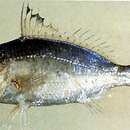Diagnostic Description
provided by Fishbase
Body silvery with 6-8 irregular, faint dusky oblique and vertical bands dorsolaterally and ventrolaterally (usually more apparent in young stressed or preserved specimens. U-shaped premaxilla groove mostly without scales (tiny scales anteriorly in specimens over 13 cm SL). Posterior margin of maxillary beyond a vertical through anterior margin of pupil. Supraneural bones 3. Spinous dorsal fin with an indistinct dusky patch (2nd-6th spines) and very narrow dusky distal margins on upper membranes between spines. Scales between 5th dorsal fin spine and lateral line 3-4, usually 3.5. Pelvic fin when fresh is semi-transparent or dull yellow color with an indistinct dusky band and dull white distal margin posteriorly (Ref. 35850); pectoral fins reaches beyond level of anus; caudal fin forked deeply and with long lobes (Ref. 90102).
- Recorder
- Estelita Emily Capuli
Diseases and Parasites
provided by Fishbase
Haplorchis Infestation 1. Parasitic infestations (protozoa, worms, etc.)
Diseases and Parasites
provided by Fishbase
Heterophyopsis Infestation. Parasitic infestations (protozoa, worms, etc.)
Morphology
provided by Fishbase
Dorsal spines (total): 9; Dorsal soft rays (total): 10; Analspines: 3; Analsoft rays: 7
- Recorder
- Estelita Emily Capuli
Trophic Strategy
provided by Fishbase
Occurs over shallow sandy areas (Ref. 6110) and along the coast, saltwater lagoons, and estuaries (Ref. 5213). Present in seagrass beds at juvenile stage. Invert. feeder (Ref. 41878).
Biology
provided by Fishbase
Found along the coast, saltwater lagoons, and estuaries (Ref. 5213). Also in sand bottoms in sheltered waters near reefs (Ref. 90102). Occurs singly or in groups (Ref. 9710). Feeds on small organisms living on sandy bottoms. Utilized as fish meal and duck food. Sold fresh in markets.
- Recorder
- Crispina B. Binohlan
Importance
provided by Fishbase
fisheries: commercial
- Recorder
- Crispina B. Binohlan
分布
provided by The Fish Database of Taiwan
分布於印度-西太平洋區,西起紅海及非洲東岸,東至西太平洋各群島。台灣西部沿海及南北礁區均見。
利用
provided by The Fish Database of Taiwan
本種魚一年四季皆有,以春、夏季較多。圍網、底拖網、流刺網及手釣皆可採獲,但魚體小,常作下雜魚處理,供養殖飼料之用,體型大者市場偶可見到。
描述
provided by The Fish Database of Taiwan
體呈長卵圓形,標準體長約為體高的3.0-3.3倍,體背於背鰭起點處略為彎曲,與水平方向軸約呈35度角。口小唇薄,能伸縮自如,伸出時向下垂。眼大,吻尖。上下頜齒細長,呈絨毛狀;鋤骨、腭骨及舌面皆無齒。體被薄圓鱗,易脫落;背鰭及臀鰭基底具鱗鞘;側線完全,呈弧狀,至尾鰭基底之側線鱗數35-39,尾鰭基底之有孔鱗3或4;側線上鱗列數3.5(側線至背鰭第V棘間,且不含側線鱗)。背鰭單一,硬棘部IX,第II棘最長,但短於頭長;臀鰭第II棘細尖狀,短於或等於眼徑長;胸鰭短,末端僅及肛門;尾鰭深叉形,最長鰭條長約與胸鰭等長。體色呈銀白色,體背淡橄欖色;體側具7-8條不顯著的橫帶;背鰭硬棘部具黑緣,有時會延伸至軟條部;尾鰭亦具有暗色緣。
棲地
provided by The Fish Database of Taiwan
棲息在沿岸沙泥地,亦可發現於河口、內灣、紅樹林等地,在珊瑚礁區周圍之沙地亦常見,以沙泥地中的無脊椎動物為食。
Common silver-biddy
provided by wikipedia EN
The common silver-biddy (Gerres oyena), also known as the blacktip silver biddy, Darnley Island silverbelly, longtail silverbiddy, oceanic silver biddy, shining silver-belly or slender silver belly,[3] is a species of mojarra native to marine and brackish waters of coastal waters of the Indian Ocean and the western Pacific Ocean. It inhabits estuaries, coastal waters and lagoons. This species can reach a length of 30 cm (12 in), though most do not exceed 20 cm (7.9 in). This species is important to local commercial fisheries.[2]
Reproduction
Based on the seasonal reproductive cycle of the species, ovary development of the females occurs from March to September, while the testes development of the males occurs between March and August. For both sexes, the maximal development occurs during April and May. Using the gonadosomatic index, the minimum standard length (SL) at sexual maturity was 89.7 mm for the females and 81.4 mm for males. The size at which 50% of individuals were sexually mature was 104 mm SL in females and 92 mm SL in males.[4]
See also
References
-
^ Munroe, T.A.; Greenfield, D. & Williams, I. (2017) [errata version of 2016 assessment]. "Gerres oyena". IUCN Red List of Threatened Species. 2016: e.T166919A115305348. doi:10.2305/IUCN.UK.2016-1.RLTS.T166919A1152301.en. Retrieved 24 February 2020.
-
^ a b Froese, Rainer; Pauly, Daniel (eds.) (2019). "Gerres oyena" in FishBase. December 2019 version.
-
^ Dianne J. Bray. "Gerres oyena". Fishes of Australia. Museums Victoria. Retrieved 24 February 2020.
-
^ Kanak, Khaled and Katsunori Tachihara. Reproductive biology of common silver biddy Gerres oyena in Okinawa Island of southern Japan, Journal Fisheries Science, Springer Japan Issue, Volume 74, Number 2 , pages 265-275, March, 2008

- license
- cc-by-sa-3.0
- copyright
- Wikipedia authors and editors
Common silver-biddy: Brief Summary
provided by wikipedia EN
The common silver-biddy (Gerres oyena), also known as the blacktip silver biddy, Darnley Island silverbelly, longtail silverbiddy, oceanic silver biddy, shining silver-belly or slender silver belly, is a species of mojarra native to marine and brackish waters of coastal waters of the Indian Ocean and the western Pacific Ocean. It inhabits estuaries, coastal waters and lagoons. This species can reach a length of 30 cm (12 in), though most do not exceed 20 cm (7.9 in). This species is important to local commercial fisheries.
- license
- cc-by-sa-3.0
- copyright
- Wikipedia authors and editors
Description
provided by World Register of Marine Species
Found along the coast and also in estuaries and saltwater lagoons (Ref. 5213). Feeds on small organisms living on sandy bottoms. Used for fishmeal and duck food. Sold fresh in markets.
Froese, R. & D. Pauly (Editors). (2023). FishBase. World Wide Web electronic publication. version (02/2023).
- license
- cc-by-4.0
- copyright
- WoRMS Editorial Board

